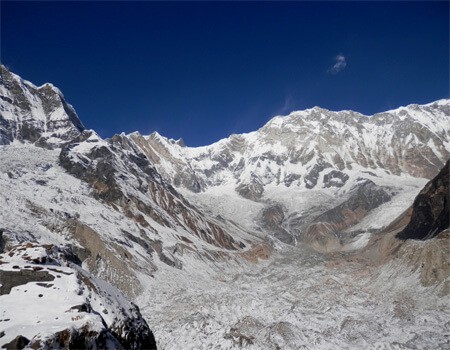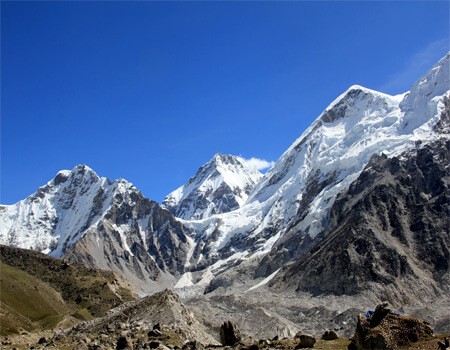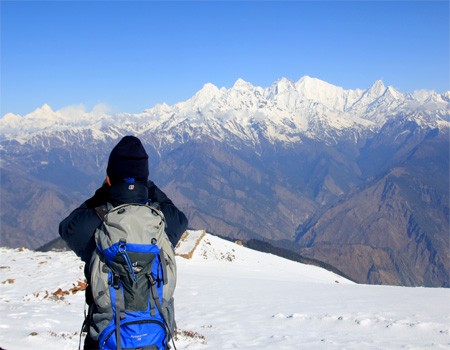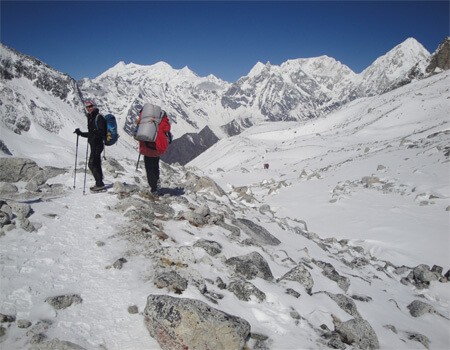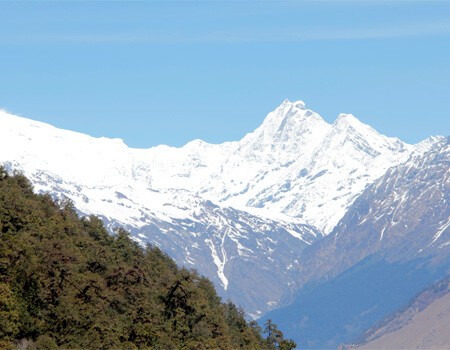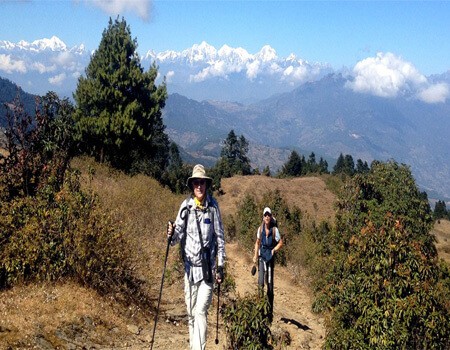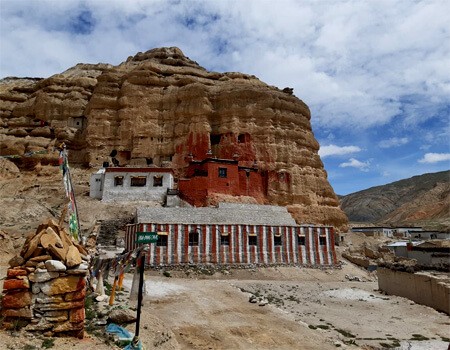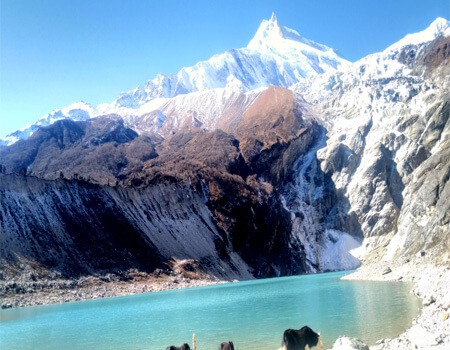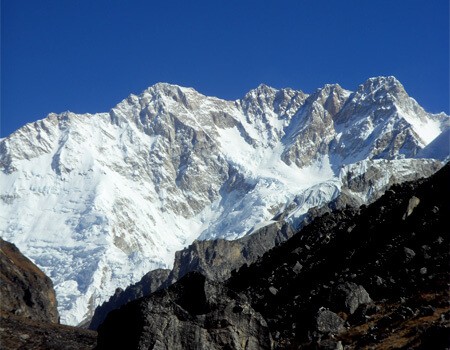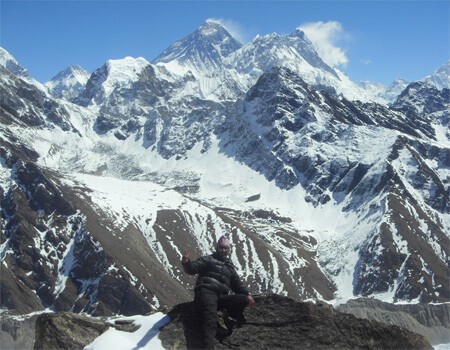About Trekking in Nepal
Trekking in Nepal is a popular activity for adventure travelers. The country is famous as a trekking paradise for trekkers worldwide. There are several fantastic mountain trails for beginners and regular adventurous hikers.
Our Nepal Trekking packages take you to the world's greatest and highest mountain ranges to see pristine sceneries, exciting history, and a warm, welcoming society. You get unforgettable hospitality from the locals in each Himalayan destination in Nepal. Nepalese Himalayas are the prime choice for adventure travelers. Most of the hiking trails in this country offer visitors safe and memorable journeys.
We operate a wide range of treks in Nepal, from accessible to strenuous routes, including the famous Everest Base Camp Trek, the Annapurna Circuit Trek, and the Annapurna Base Camp Trek to remote and less-crowded regions such as Langtang Valley and Manaslu Circuit.
It is hard to categorize the best trek in Nepal. There are numerous pristine Himalayan journeys in this beautiful country. Once you hike to one Himalayas or one route in Nepal, it inspires you to go to the others and visit Nepal regularly. Nepal is a safe country to travel to, and the Vergine trekking trails are sublime destinations from which to escape to nature and walk close to the towering white mountains.
Hiking in the Nepalese mountain regions is much more comfortable than walking in most other countries' Himalayas—plenty of tea houses with various food items, including local and Western. Trekkers even get some luxury accommodations in the lower regions of some base camp trekking routes in Nepal. We mainly focus on ecotourism, introducing variations of culture while experiencing outstanding scenery. Trekking to Nepal is also a great chance to experience virgin nature and its charm.
Frolic Adventure facilitates local trekking experts and guides to take to famous mountain destinations, who provide the most authentic information with your safety focus. We also use local porters from the particular regions, who will support the locals in their basic living.
How to Decide Where to Trek in Nepal
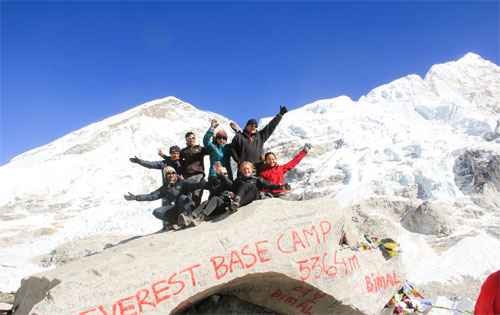
Trekkers are at Everest Base Camp, taking a group picture and bright mountain views in autumn weather with the blue sky.
There are glorious trekking destinations in Nepal. You might be confused about which one is the best for you. Pick any mountain region and trail according to your time and physical condition. You can also provide us with the duration of your Nepal travel and hiking experience with the elevation details of the places you have visited.
For your quick reminder, the first thing to figure out is how many days you have to trek in Nepal and what types of stamina you have. Suppose you plan to visit mountain base camps like Everest, Annapurna, Manaslu, Kanchenjunga, or other regions in Nepal. In that case, you must have two weeks or more time to complete it. Also, you need 15 days to three weeks for adventure high passes trekking in Nepal. Still, some short and easy hiking trails exist for beginners, families, elderlies, and those traveling to Nepal for one week or less. We are also arranging short treks to Everest Base Camp and Annapurna Base Camp for those who have limited time and would like to do a quicker visit to the base of the high mountains.
You can also pick our shorter trekking packages to Everest, Annapurna, Langtang, and some near Kathmandu Valley. Everest Panorama in the Khumbu Region is the shortest trek, where you can explore Sherpa Culture, tradition, and lifestyle with the mighty Himalayas and untouched nature. Poon Hill and Mardi Himal are the most famous short hiking packages in the Annapurna Region. Also, you can go for off-beaten virgin trails like Khopra Danda, Mohare Danda, and the Indigenous People's Trail in Nepal. Likewise, Chisapani Nagarkot is the best trail for those in Nepal, lasting for three days to one week. Suppose you are a usual trekker and love adventure routes for over two weeks. In that case, we suggest the high passes itineraries like Everest Base Camp with Gokyo Lakes, Annapurna Circuit, Everest Three Passes, Manaslu Circuit, Kanchenjunga Circuit, Langtang Gosaikunda, and Kanchenjunga Circuit trails, which are classic adventure treks in Nepal.
Similarly, it is another part of which region you would like to explore. There are numerous delightful Himalayan Regions in Nepal with different landscapes, cultures, natural attractions, and more in each area. The Khumbu begins from Lukla and goes up to the Khumbu Glacier, from where the slopes of Mount Everest arise. It is one of the most incredible journeys for everyone to reach the basement of the world's highest mountain through charming valleys while viewing towering high snow-capped peaks. The journey to the bottom of Everest begins from Lukla, where you can fly in from Kathmandu or Ramechhap.
Nepal's remote and restricted region trekking destinations are Manaslu, Mustang, Kanchenjunga, and Dolpo. Trekkers must obtain special entry permits to trek in these areas. Manaslu Circuit has more significant numbers of trekkers among the unique hiking trails than the other routes.
The Annapurna Region has more visitors than the others in Nepal. It offers various trekking routes, from easy to strenuous, with easy access, budget-friendly, and beginner-friendly trails. Annapurna Circuit with Tilicho Lake is the best package for adventure trekkers and Poon Hill, Mardi Himal, Khopra, or Mohare Danda are best for first-time, families, and elderlies trekkers.
The most important thing to consider before choosing a particular trekking destination in Nepal is your fitness and altitude. However, anyone with positive determination can trek in Nepal at least to lower elevations without attempting some base camps and high passes over five thousand meters. Be sure to which elevation you plan to visit and stay many nights in cold temperatures. Before hiking in Nepal, we suggest physical training like swimming, hiking, cardio, and leg exercises.
Being physically fit does not always mean being mountain fit for everyone. A strong and healthy person at lower altitudes sometimes struggles in high elevations. A slow-walking trekker may stay safe and succeed in higher altitude hikes than a fast-walker strong person, so an intelligent traveler walks comfortably and slowly to keep the body acclimatized and not face any mountain sickness while hiking in Nepal.
Now, we will introduce some popular trekking regions here that can be beneficial.
Everest Region
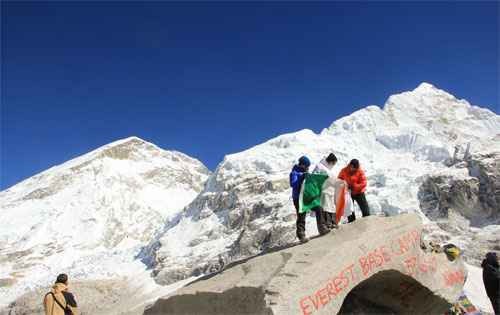
Trekkers are with their nation's flag at the Everest Base Camp, Mount Lola, and Nuptse views.
People who think of Nepal first think of Everest because it is the world's tallest mountain. This region has hundreds of pristine mountains with three peaks above eight thousand meters. There are numerous trekking trails in the Khumbu Himalayas, and the Everest Base Camp Trek is the most famous, with millions of visitors each year. Gokyo Lakes trail is an alternative to the base camp, with fewer crowds. You can combine Gokyo and Base Camp, crossing Cho La to explore both routes. The Three High Passes trail is the most adventurous, perfect for highly adventurous people. Likewise, Renjo La Pass offers the best views of the Khumbu Himalayas, which is less popular than the others in this region. The Everest View Panorama Trek to Tengboche Hill is the best for people who do not think of reaching the base camp or five thousand-plus elevations but love to see the world's highest mountain from a close distance.
Annapurna Region
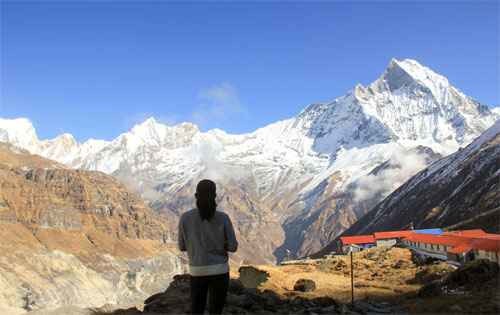
Mount Fishtail view from the Annapurna Base Camp and trekking lodges.
The Annapurna is the second most famous trekking region in Nepal. It still has more visitors than the other Himalayas. There are numerous short and well-known routes like Poon Hill, Mardi Himal, Mohare Hill, Khopra Ridge, and more. However, the Poon Hill, Mardi Himal, and Annapurna Base Camp trails have more trekkers because of their popularity. The Annapurna Circuit and Tilicho Lake with Thorong La Pass routes also have hundreds of adventure travelers each day during the high trekking seasons in Nepal.
Langtang Region
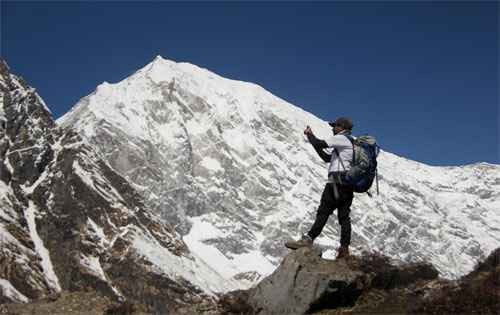
A Trekking Guide at Kyanjin Ri, taking a photo of Mount Langtang Lirung in Langtang Region.
Several trekking routes are in the Langtang Region, inside the Langtang National Park. It is the nearest mountain hike from Kathmandu, bringing visitors close to massive mountains within two to three days. Hiking to Langtang Himalayas is not just a journey to see mountains. It is also a cultural journey to explore Tibeto-Nepalese Tamang culture. The national park has charming wildlife like red pandas, deer, bears, leopards, and more, with some reptiles. Also, this National Park has three hundred plus various bird spaces, so trekking to Langtang Region can be the perfect journey for birdwatchers.
Langtang Valley Trek attracts more trekkers than the other trails in this region. However, Gosaikunda Lake still attracts more visitors for religious reasons. The lake and temple are the most sacred places for Hindus and Buddhists. If you want an adventurous journey in the Langtang Region, our Langtang Gosaikunda with Lauribina La Pass is best for you in the Himalayas.
Manaslu Region
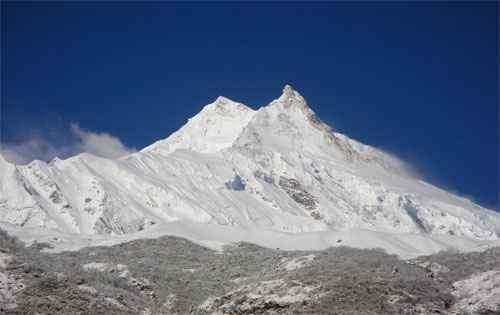
Mount Manaslu View from Samagaun in Manaslu Region.
Manaslu is a restricted trekking region in Nepal. There are limited numbers of visitors are allowed to travel. So, the route will be quieter than that of other commercial destinations. This Himalayas has two known trails, the Manaslu Circuit and Tsum (Chum) Valley. You can go for either one or combine both simultaneously if you have many days.
Mustang Region
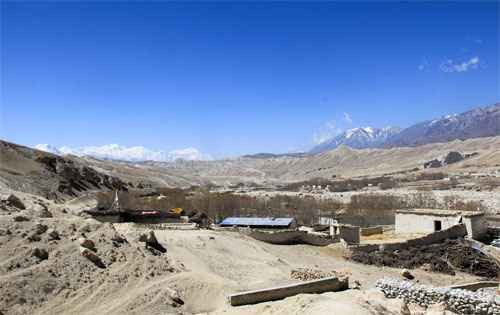
Mountain View and Exceptional Landscapes of Mustang Region.
The Mustang is behind the Annapurna Mountains. It is also called the region across the mountains. You can trek to the Mustang even during monsoon season because it is a rain-shadow area. It is very close to Tibet, and the landscapes are similar to those in Tibet. Upper Mustang is restricted, so visitors must pay five hundred USD for ten days to travel here. However, the lower Mustang, like visiting Muktinath, Jomsom, and Kagbeni, is standard and can go with having regular Annapurna Conservation Permits.
When is the Best Time to Trek in Nepal?
The most important thing to consider when trekking in Nepal is the best time or season. Choose a time for your mountain journey when the weather is pleasant and pleasant. The best times to trek in Nepal are during the pre-monsoon season, which lasts from April to May, and the post-monsoon season, which lasts from September to December. However, the first weeks of September and the last half of May will have some rainy days.
The post-monsoon months are delightfully bright, ensuring the best visibility in the mountains. The forests look dark green, and cherry blossoms bloom in some regions of Nepal. In autumn weather, you can see the mighty Himalayas from afar. Although winter comes right after autumn, temperatures fall daily to cold in the mountain regions.
Pre-monsoon, from March to May, is the warm season when you can see colorful forests with blooming flowers. It is a dry season, so the days in the valley might have lots of haze, but still, the mountains look pristine and straightforward once you reach higher and closer to them.
What is the Weather Like in the Nepalese Himalayas?
The temperature in the Nepalese Himalayas is adorable, and it does not freeze during the day while you are walking. However, the temperatures vary according to the seasons and time of the day. It will be warmer in the lower regions of each trekking route and degrees to lower degrees in the higher elevations. The wind and clouds make it colder in high-altitude areas, so remember to pack some warm clothes like a fleece jacket/wind stopper, winter hat, and gloves in your daypack while walking if you pack them in your main trekking gear bag, which the porter carries. The porter might not stay with you all the time during your walk. Rain gear also keeps with you in your daypack in case of rain or snowfall on the way.
How Difficult to Trek in Nepal?
It is tricky to say about the difficulties of the trek in Nepal. A mountain trip is, of course, not a luxury activity. It is an adventure task. However, measuring is tricky and easy to trek in Nepal according to the destination you will visit. Choosing some low-elevated regions is more accessible than choosing high passes and base camp trips.
It also depends on how trekkers act and move in the mountains to make a successful trek in the Nepalese Himalayas. Altitude is a significant difficulty for trekkers, but slow walking and acclimatizing are essential to Nepal hiking. Trekking in Nepal is not a competition to win a prize; it is a trip to explore magnificent nature and culture by escaping the great Himalayas of Nepal.
What to Pack to Trek in Nepal?
We arrange lodge-lodge trekking in Nepal. You do not have to pack tents and food for any mountain trip booking with us. However, you are going to the cold regions, so you must have a quality sleeping bag, which we provide if you do not have one. A Down Jacket for mornings and evenings is essential. You may not be able to wash trekking socks and shirts in the cold region, so remember to pack enough trekking shirts and socks. A Fleece jacket, wind stopper, thermal layers, and windproof trousers are a must to pack to trek in Nepal.
The amount and different types of trekking gear to pack for Nepal depend on the days, elevations, and seasons. You must pack warmer equipment for autumn and winter than for spring because of the temperature. You must wear sunscreen and a hat while walking in the Nepalese Himalayas. Also, some trekking camps are long, so pack day snacks for the day with you in your daypack. You can ask us what to pack after you book your trek in Nepal with us. We are always happy to provide authentic information regarding your trip with us.
How to Stay Safe from Altitude Sickness?
Altitude Sickness can occur for anyone at any time above three thousand meters in the Nepalese Himalayas. However, following certain things can minimize the risk of mountain sickness while you trek in Nepal. The most important thing is staying hydrated by drinking plenty of clean water during the day. You must drink more as you go to higher elevations.
Try to walk comfortably by ambling while ascending to make your breath easy. Also, do not travel with a tight time and always take acclimatization spare day for altitude practice. Most travelers lose apatite at high elevations. We suggest not skipping any main course because the body needs food. Also, cold and wind make trekkers uneasy and sick, so wear warm clothes and change sweaty clothes as soon as possible.
Not thinking all the time about the altitude effect and taking it positively also helps minimize the risk of mountain sickness. We hope you won't suffer from altitude sickness while trekking in the Nepalese Himalayas with us. Still, some trekkers will get it. What do you do if you suffer from acute mountain sickness? We suggest resting at the same place for an extra night or descending to a lower elevation as soon as possible, depending on the condition. We focus on a successful trip and our customer's safety at the same time.
Visa Requirement to Trek in Nepal
Except for the nationalities of Nigeria, Ghana, Cameroon, Zimbabwe, Palestine, Afghanistan, Swaziland, Syria, Ethiopia, Iraq, Liberia, and Somalia, citizens of the rest countries will get on-arrival tourist visas at the international airport and land borders. Those who won't get a visa on arrival to trek in Nepal must obtain one from the nearest Nepalese Embassy or consulate.
The tourist visa for Nepal has different categories, depending on the length of stay. It costs 30 USD for 15 days, 50 USD for one month, and 125 USD for 90 days for a tourist visa in Nepal.
Note: There can be a long queue at the visa-issuing place at the airport in Kathmandu. To make it easier, you can obtain your visa in your country or online before you travel to Nepal to trek to the Himalayas.
Trekking in the Nepalese Himalayas is a mesmerizing journey and a lifetime experience. You will have a great chance to explore lovely culture and eye-captivating nature with excellent hospitality from the locals in each region and route.
